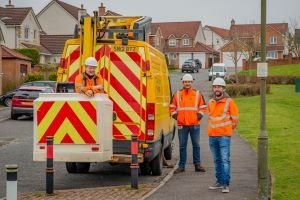
The programme of replacing street lights with eco-friendly LED replacements began in 2014/15 and is now 85% complete, resulting in the massive drop in carbon emissions equal to 8,363 tons.
The replacement of over 41,000 street lights has also led to a 50% drop in energy consumption in the last seven years. This is despite growth in the total number of street lights maintained by the council by 5% over the seven-year period.
Over the next seven years, a further £16.4 million of investment is planned on road lighting works to complete the LED replacement programme, along with other upgrades and improvements such as lighting column replacements and cabling renewal.
Executive councillor for the environment Tom Conn said: "West Lothian Council is committed to reducing the environmental impact of the essential services we deliver.
"It's fantastic to see the street lighting programme deliver such superb reductions in both carbon emissions and energy use.
"The investment of £16.4 million over the next seven years will continue to minimise our environmental impact, while maintaining and improving the amenity and safety for local residents that street lighting provides."
The programme also includes a number of specific street improvements works across West Lothian up to 2027/28.
These include: Bishops Park, Mid Calder; Braehead/Stewart Avenue Area, Linlithgow; Brown Street/Hailstanes Crescent, Armadale; Brucefield Industrial Estate, Brucefield, Livingston; Carnegie Road, Deans, Livingston; Dedridge North Road, Dedridge, Livingston; East Bankton Place, Bankton, Livingston; Easton Road, Bathgate; Ecclesmachan Road, Uphall; Kilpunt Roundabout, Broxburn to boundary with Edinburgh; Main Street, Mid Calder; Main Street/Kirk Lane/Charlesfield Lane, Livingston Village; Palmer Rise, Dedridge, Livingston; Staunton Rise, Dedridge, Livingston; and Westcraigs Road, Blackridge.
Pictured left to right are members of the council's Street Lighting team Malcolm Lauder, Graeme Marshall and Alan Rutherford.

